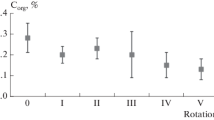Abstract
The effects of rate of N and P fertilizer, type of fertilizer material and application method on establishment, growth and tissue nutrient concentrations of Spartina alterniflora were evaluated on an eroding estuarine shoreline. Both N and P were growth limiting factors at the test site. Biomass increased with increasing rates of N and P up to 224 kg per ha N and 49 kg per ha P when ammonium sulfate and concentrated superphosphate were banded at planting. There were only slight increases in growth when either N or P were applied alone. Placement of fertilizer below ground was necessary; there was no growth response to surface application at transplanting time. The slow-release fertilizers, Mag Amp and Osmocote, supplied N over a longer period of time and produced more growth than the other sources of N which were tested. Urea and urea-formaldehyde were ineffective sources of N. Concentrated superphosphate was as effective as the slow-release fertilizers as a source of P. Nitrogen concentrations in fertilized plants which produced more biomass were lower than in those plants stunted by lack of N or P except where near optimum amounts of N were supplied by the slow-release fertilizers. Residual effects of the fertilizer were evident the second growing season but top-dressing with N and P was necessary to maintain a vigorous stand. Accumulation of up to 28 cm of sand in 2 years was evidence of reduction of shoreline erosion.
Similar content being viewed by others
Literature Cited
Barr, A. J., J. H. Goodnight, J. P. Sall, W. H. Blair, and D. M. Chilko. 1979. SAS User's Guide. SAS Institute, Inc., P.O. Box 10066, Raleigh, North Carolina.
Broome, S. W., W. W. Woodhouse, Jr., and E. D. Seneca. 1975. The relationship of mineral nutrients to growth of Spartina alterniflora in North Carolina: II. The effects of N, P, and Fe fertilizers. Soil Sci. Soc. Am. Proc. 30:301–307.
Chalmers Alice G. 1979. The effects of fertilization on nitrogen distribution in a Spartina alterniflora salt marsh. Estuarine Coastal Mar. Sci. 8:327–337.
DeLaune R. D., W. H. Patrick, Jr., and J. M. Brannon. 1976. Nutrient transformations in Louisiana salt marsh soils. Sea Grant Publication No. LSU-T-76009 Louisiana State University Baton Rouge.
Dodd, J. D. and J. W. Webb. 1975. Establishment of vegetation for shoreline stabilization in Galveston Bay. MP 6-75, U.S. Army, Corps of Engineers Coastal Engineering Research Center, Fort Belvoir, Virginia.
Gallagher, J. L.. 1975. Effect of an ammonium nitrate pulse on the growth and elemental composition of natural stands of Spartina alterniflora and Juncus roemerianus. Am. J. Bot. 62:644–648.
Garbisch, E. W., P. B. Woller, and R. J. McCollum. 1975. Salt marsh establishment and development. TM-52. U.S. Army, Corps of Engineers, Costal Engineering Research Center, Fort Belvoir, Virginia.
Knutson, P. L. 1977a. Planting guidelines for marsh development and bank stabilization. CETA 77-3, U. S. Army, Corps of Engineers, Coastal Engineering, Research Center, Fort Belvoir, Virginia.
Knutson, P. L.. 1977b. Designing for bank erosion control with vegetation, p. 716–733. In Coastal Sediments'77, American Society of Civil Engineers, New York.
Linthurst, R. A., and E. D. Seneca. 1981. Aeration, nitrogen, and salinity as determinants of Spartina alterniflora Loisel. growth response. Estuaries 4:53–63.
Mehlich, A.. 1978. New extractant for soil test evaluation of phosphorus, potassium, calcium, sodium, manganese and zinc. Commun. in Soil Sci. and Plant Anal. 9:477–492.
Mendelssohn, I. A. 1979a. The influence of nitrogen level, form, and application method on the growth response of Spartina alterniflora in North Carolina. Estuaries 2:106–112.
Mendelssohn, I. A. 1979b. Nitrogen metabolism in the height forms of Spartina alterniflora ion North Carolina. Ecology 60:574–584.
Odum, W. E., and S. S. Skjei. 1974. The issue of wetlands preservation and management: A second view. Coastal Zone Management Journal 1:151–163.
Patrick, W. H., and R. D. DeLaune. 1976. Nitrogen and phosphorus utilization by Spartina alterniflora in a salt marsh in Barataria Bay, Louisiana. Estuarine Coastal Mar. Sci. 4:59–64.
Soil Conservation Service. 1975. Shoreline Erosion Inventory. U. S. Department of Agriculture, Raleigh, North Carolina.
Steele, R. G. D., and J. H. Torrie. 1960. Principles and Procedures of Statistics. McGraw-Hill Book Company, Inc, New York.
Sullivan, M. L., and F. C. Daiber. 1974. Response in production of cordgrass, Spartina alterniflora, to inorganic nitrogen and phosphorus fertilizer. Chesapeake Sci. 15:121–123.
Teal, J. M. 1962. Energy flow in the salt marsh ecosystem of Georgia. Ecology 43:614–624.
Valiela, I., and J. M. Teal. 1974. Nutrient limitation in salt marsh vegetation, p. 547–563. In R. J. Reimold and W. H. Queen (eds.), Ecology of Halophytes. Academic Press, Inc., New York.
Williams, R. B., and M. B. Murdoch. 1969. The potential importance of Spartina alterniflora in conveying zinc, managanese, and iron into estuarine food chains, p. 431–439. In D. J. Nelson and F. C. Evans (eds.), Proceedings of the Second National Symposium on Radioecology, USAEC, CONF-670503, Ann Arbor, Michigan.
Woodhouse, W. W., Jr. E. D. Seneca, and S. W. Broome. 1974. Propagation of Spartina alterni-flora for substrate stabilization and salt marsh development. TM-46. U. S. Army, Corps of Engineers, Coastal Engineering Research Center, Fort Belvoir, Virginia.
Woodhouse, W. W., Jr. E. D. Seneca, and S. W. Broome. 1976. Propagation and use of Spartina alterniflora for shoreline erosion abatement. TR 76-2, U.S. Army, Corps of Engineers, Coastal Engineering Research Center, Fort Belvoir, Virginia.
Author information
Authors and Affiliations
Additional information
Paper number 6781 of the Journal of the North Carolina Agricultural Research Service, Raleigh, North Carolina 27650. Mention of a trademark or proprietary product does not constitute a guarantee or warranty of the product by North Carolina State University and does not imply its approval to the exclusion of other products that may be suitable.
Rights and permissions
About this article
Cite this article
Broome, S.W., Seneca, E.D. & Woodhouse, W.W. The effects of source, rate and placement of nitrogen and phosphorus fertilizers on growth of Spartina alterniflora transplats in North Carolina. Estuaries 6, 212–226 (1983). https://doi.org/10.2307/1351513
Received:
Accepted:
Issue Date:
DOI: https://doi.org/10.2307/1351513




